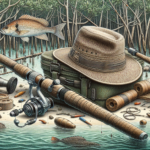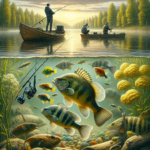Fishing Tips on How to Catch Spotted Seatrout

Introduction
Spotted seatrout, also known as speckled trout, are a popular target for sport and recreational anglers. Known for their distinctive spots and aggressive strikes, these fish provide an exciting challenge for both novice and experienced fishermen. This article will delve into the specifics of catching spotted seatrout, covering everything from their physical characteristics and habitats to the best fishing techniques and gear. Whether you’re a seasoned angler or a beginner, these tips will help you improve your chances of landing this prized species.
Fish Species Overview
Description
Spotted seatrout (Cynoscion nebulosus) are easily recognizable by their elongated bodies, silvery color, and distinctive black spots that run along their backs and tails. They typically range in size from 1 to 5 pounds, although larger specimens, known as “gator trout,” can exceed 10 pounds. Their mouths are equipped with sharp teeth, making them effective predators.
Habitat
Spotted seatrout are primarily found in coastal waters, thriving in both saltwater and brackish environments. They are commonly found in estuaries, bays, and lagoons, where they seek out seagrass beds, oyster reefs, and other structures that provide cover and abundant prey. Regions such as the Gulf of Mexico, the Atlantic coast of the United States, and the coastal waters of the southeastern U.S. are particularly known for their spotted seatrout populations.
Behavior
Spotted seatrout are opportunistic feeders, preying on a variety of small fish, shrimp, and crabs. They are most active during dawn and dusk, making these times ideal for fishing. Spawning typically occurs from late spring to early summer, during which time they move to shallow waters. Anglers often face challenges such as the fish’s wariness and their tendency to be more active during low-light conditions.
Best Time to Catch Spotted Seatrout
Seasonal Considerations
The best time to catch spotted seatrout is during the warmer months, from late spring through early fall. During this period, the fish are more active and can be found in shallower waters, making them easier to target.
Time of Day
Spotted seatrout are most active during the early morning and late evening hours. Fishing during these times increases your chances of success, as the fish are more likely to be feeding.
Weather Conditions
Ideal weather conditions for catching spotted seatrout include overcast days and calm waters. Cloudy skies reduce light penetration, making the fish less wary and more likely to strike. Calm waters also make it easier to detect subtle bites.
Top Fishing Techniques for Spotted Seatrout
Technique 1: Live Bait Fishing
Using live bait, such as shrimp or small fish, is highly effective for catching spotted seatrout. Rig the bait on a popping cork or a free-line setup to keep it at the desired depth. The natural movement of live bait attracts the fish and entices them to strike.
Technique 2: Soft Plastic Lures
Soft plastic lures, such as paddle tails and jerk baits, mimic the movement of small fish and are excellent for targeting spotted seatrout. Use a jig head to rig the lure and vary your retrieval speed to find what works best. These lures are particularly effective in seagrass beds and around structures.
Technique 3: Topwater Lures
Topwater lures, such as poppers and walk-the-dog baits, create surface commotion that attracts spotted seatrout. These lures are most effective during low-light conditions, such as early morning or late evening. The visual and auditory stimuli of topwater lures trigger aggressive strikes from the fish.
Pro Tips
- Use a fluorocarbon leader to reduce visibility and increase your chances of a strike.
- Pay attention to tidal movements, as spotted seatrout are more active during incoming and outgoing tides.
- Experiment with different retrieval speeds and techniques to find what works best on a given day.
Recommended Gear for Catching Spotted Seatrout
Fishing Rod and Reel
A medium-light to medium-action spinning rod paired with a 2500 to 3000 series reel is ideal for catching spotted seatrout. This setup provides the sensitivity needed to detect subtle bites while offering enough power to handle larger fish.
Fishing Line
Use a 10 to 15-pound braided line for its strength and sensitivity. Pair it with a 20 to 30-pound fluorocarbon leader to reduce visibility and increase abrasion resistance.
Hooks and Baits
For live bait fishing, use size 1/0 to 3/0 circle hooks. When using artificial lures, opt for jig heads in the 1/8 to 1/4-ounce range. Popular baits include live shrimp, mullet, and pinfish, as well as soft plastic lures and topwater plugs.
Additional Gear
- Popping corks to keep live bait at the desired depth.
- Sinkers to help control the depth of your bait or lure.
- Landing net to safely land and handle the fish.
Best Locations to Find Spotted Seatrout
General Locations
Spotted seatrout are commonly found in coastal waters, including estuaries, bays, and lagoons. Look for areas with seagrass beds, oyster reefs, and other structures that provide cover and attract prey.
Specific Regions
Popular regions for catching spotted seatrout include the Gulf of Mexico, the Atlantic coast of the United States, and the coastal waters of the southeastern U.S. Notable spots include the Texas coast, Florida’s Indian River Lagoon, and Louisiana’s marshes.
Common Mistakes to Avoid
Mistake 1: Using the Wrong Gear
Using gear that is too heavy or too light can hinder your success. Ensure you have the appropriate rod, reel, line, and hooks for targeting spotted seatrout.
Mistake 2: Ignoring Tidal Movements
Tides play a significant role in the activity of spotted seatrout. Fishing during slack tides can be less productive, so focus on incoming and outgoing tides for better results.
Mistake 3: Overlooking Structure
Spotted seatrout are often found near structures such as seagrass beds, oyster reefs, and docks. Ignoring these areas can reduce your chances of success. Always target structures that provide cover and attract prey.
Catch and Release Tips
Importance of Conservation
Practicing catch and release helps ensure the sustainability of spotted seatrout populations. Ethical fishing practices contribute to the long-term health of the species and the overall ecosystem.
Proper Handling Techniques
- Use wet hands or a wet cloth to handle the fish, reducing the removal of their protective slime coating.
- Avoid touching the gills and eyes, as these areas are particularly sensitive.
- Use a dehooking tool to remove the hook quickly and minimize injury.
- Release the fish gently back into the water, supporting its body until it swims away on its own.
Legal Considerations
Be aware of local regulations regarding size limits, bag limits, and protected areas. Adhering to these rules helps maintain healthy fish populations and ensures a sustainable fishery for future generations.
Frequently Asked Questions (FAQs)
What is the best bait for catching spotted seatrout?
The best bait for catching spotted seatrout includes live shrimp, mullet, and pinfish. Soft plastic lures and topwater plugs are also effective, especially when mimicking the movement of small fish.
Where is the best place to fish for spotted seatrout?
Spotted seatrout are commonly found in coastal waters, including estuaries, bays, and lagoons. Popular fishing spots include the Gulf of Mexico, the Atlantic coast of the United States, and the coastal waters of the southeastern U.S.
What time of day is best for catching spotted seatrout?
The best time of day to catch spotted seatrout is during the early morning and late evening hours. These times coincide with their peak feeding activity, increasing your chances of success.
What type of fishing line should I use for spotted seatrout?
A 10 to 15-pound braided line is recommended for its strength and sensitivity. Pair it with a 20 to 30-pound fluorocarbon leader to reduce visibility and increase abrasion resistance.
Do I need a special fishing license to catch spotted seatrout?
Yes, you typically need a fishing license to catch spotted seatrout. Check local regulations for specific requirements, including size limits, bag limits, and any special permits needed.
What is the best technique for catching spotted seatrout?
Effective techniques for catching spotted seatrout include live bait fishing, using soft plastic lures, and topwater lures. Each technique has its advantages, so experiment to find what works best for you.
Are there any specific weather conditions that improve the chances of catching spotted seatrout?
Overcast days and calm waters are ideal for catching spotted seatrout. Cloudy skies reduce light penetration, making the fish less wary, while calm waters make it easier to detect subtle bites.
Can I catch spotted seatrout from the shore, or do I need a boat?
You can catch spotted seatrout from both the shore and a boat. Shore fishing is effective in areas with access to seagrass beds, oyster reefs, and other structures. A boat allows you to reach more remote and productive spots.
How can I improve my chances of landing a big spotted seatrout?
To catch larger spotted seatrout, use larger baits or lures, fish during low-light conditions, and target areas with abundant prey and cover. Pay attention to tidal movements and weather conditions to increase your chances of success.
What should I do if I plan to release spotted seatrout after catching them?
Practice ethical catch and release techniques, such as using wet hands to handle the fish, avoiding contact with sensitive areas, and using a dehooking tool to minimize injury. Release the fish gently back into the water, supporting its body until it swims away on its own.
Conclusion
Catching spotted seatrout can be a rewarding experience for anglers of all skill levels. By understanding their behavior, using the right techniques and gear, and practicing ethical fishing practices, you can increase your chances of success while contributing to the conservation of this valuable species. So grab your gear, head to your favorite fishing spot, and put these tips to the test. Happy fishing!




